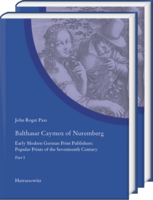|
|
more titles of the subject:
Balthasar Caymox (1561‒1635), a Flemish émigré who settled in Nuremberg in 1590 is one of the most important German print publishers of the early seventeenth century. Reflecting the aesthetic sensibilities of his Flemish background, he eschewed the popular woodcut prints that once dominated local markets in favor of more refined products executed through engraving and etching. The nearly 600 surviving prints come from 120 European and American collections, and many suggest an intended audience of educated urban consumers with a preference for visually sophisticated and intellectually stimulating imagery. Other dealers throughout the Holy Roman Empire followed his lead, and it is clear that Caymox played a pivotal role in revitalizing the trade in popular German prints.
For the production of his prints, Caymox employed leading printmakers both in- and outside of Nuremberg, including Theodor Bang, Gregorius Fentzel, Jacob von der Heyden, Peter Isselburg, Dietrich Krüger, Johann Sibmacher, and Gabriel Weyer. The types of prints they produced are varied and indicate the broad interests of consumers at the time: maps, portraits, devotional prints, broadsheets, allegories, ornamental prints, etc. Caymox served as an inspiration for other print publishers, and by the time of his death in 1635, he had been instrumental in reestablishing Nuremberg as a leading center of print production not only within the empire, but throughout Europe. In subsequent years the firm continued to prosper under the leadership of his successor Paulus Fürst. |






